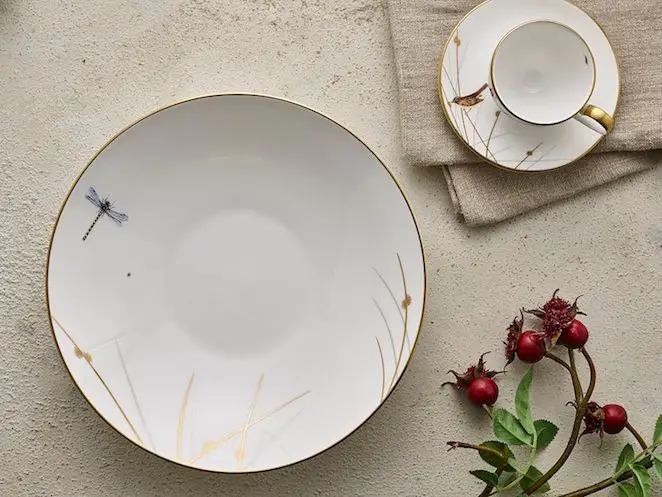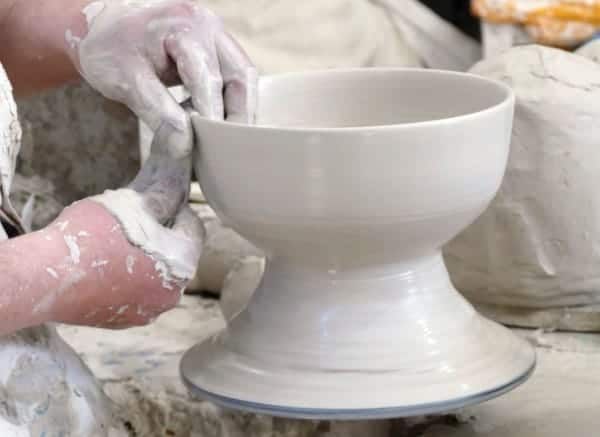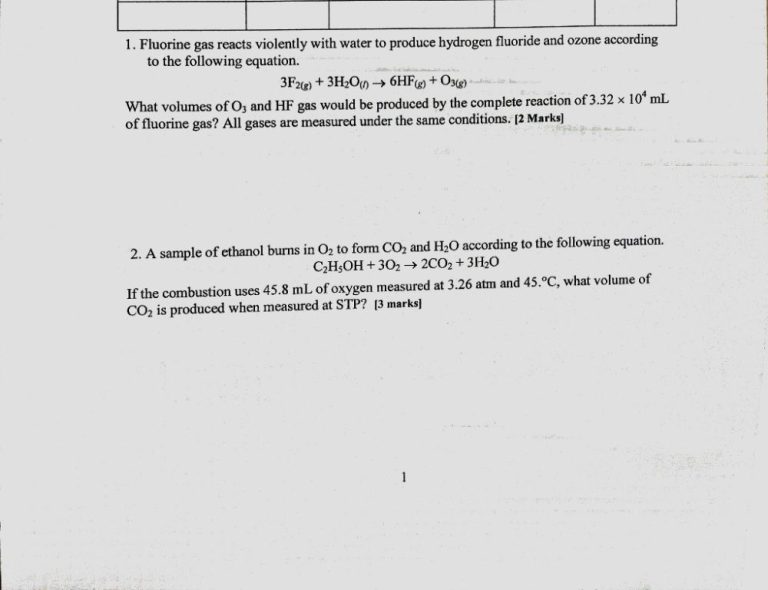How Can You Tell The Difference Between Bone China And Fine China?
Bone china and fine china are both types of porcelain that are commonly used to make elegant tableware such as plates, cups, and saucers. While they look quite similar, there are some key differences in their composition and manufacturing process that affect their appearance, feel, and price.
Bone china contains animal bone ash, which gives it a very smooth, delicate appearance and feel. Fine china does not contain bone ash and tends to be thinner and more translucent. Bone china and fine china also use different clay compositions and firing processes to achieve their distinct qualities.
This article will explore the history, composition, manufacturing, appearance, and pricing differences between bone china and fine china to help readers understand how to distinguish between the two.
What is Bone China?
Bone china is a type of porcelain that contains at least 30% bone ash. The inclusion of bone ash in the composition gives bone china high whiteness and translucency compared to other types of porcelain (Merriam-Webster). Bone ash is derived from animal bones, commonly cattle bones, that have been calcined or burned at high temperatures until it becomes calcium phosphate (Dictionary.com). The high content of bone ash is what distinguishes bone china from other types of porcelain.
What is Fine China?
Fine china refers to high-quality porcelain tableware. According to Collins Dictionary, fine china is “China is a hard white substance made from clay. It is used to make things such as cups, bowls, plates, and ornaments.” In other words, fine china is porcelain dishware made from kaolin clay that is known for its thinness, translucency, whiteness, strength, and delicacy.
Fine china is made from premium kaolin clay and often features delicate decorations like gilding or hand-painting. It is thinner and more translucent than regular chinaware. Fine china is considered the highest quality and most elegant type of porcelain dinnerware.
Composition
Bone china is composed of approximately 50% bone ash, 25% china clay, and 25% feldspar. The high bone ash content gives bone china its characteristic translucency and whiteness. According to research, the bone ash is sourced from cattle bones that are burned and then finely ground into a powder to achieve the desired composition (https://www.royalwarechina.com/what-is-bone-china/). The china clay provides plasticity and strength while the feldspar acts as a flux to lower the vitrification temperature. This precise combination of raw materials allows bone china to be fired at a lower temperature compared to other porcelains, resulting in less shrinkage and reducing production costs (https://www.sciencedirect.com/science/article/pii/S2468227618303983). The bone ash content is significantly higher than in traditional soft-paste porcelain, which gives bone china its reputation for being the strongest and most highly vitrified type of fine china.
Composition
Fine china is made from kaolin clay, quartz and feldspar. Kaolin clay, also known as China clay, is a white clay that provides the translucency and whiteness associated with fine china. Quartz adds strength and stability, while feldspar acts as a flux to lower the vitrifying temperature of the porcelain body. Some manufacturers may also add small amounts of alumina or bone ash to their porcelain blends.
The three key ingredients – kaolin, quartz and feldspar – make up at least 25% of the total body composition. The exact ratios vary by manufacturer but generally consist of 50% kaolin, 25% quartz and 25% feldspar. Adding alumina or bone ash decreases the amount of kaolin in the blend. The remaining portion contains secondary minerals that modify the plasticity and workability of the porcelain.
According to the source from Belleek Claddagh Dinnerware, “Belleek dessert plate features fine china composition that is enhanced with an embossed border that highlights the Claddagh icon and interwoven Celtic knot-work motif at rim.” This reflects the typical composition of fine china containing kaolin clay, quartz and feldspar.
The source from Restaurant Ware Collectors Network also mentions “fine china composition” when describing the Webster brand of dinnerware. This further confirms that fine china is characterized by its specialized clay composition.
Manufacturing Process
Bone china gets its name and distinctive qualities from the way it is produced. The manufacturing process involves firing animal bone ash, or calcined bone, along with fine clay and feldspar at very high temperatures of around 1,200°C to 1,300°C (2,200°F to 2,400°F). The bone ash, which is added at around 45-50% of the total body material, creates the translucent white appearance and hardness that bone china is known for.
Here are the key steps involved in manufacturing bone china:
- Raw materials like kaolin, quartz, and bone ash are precisely weighed and mixed according to the desired formula. This bone ash is derived by heating cattle bones to extremely high temperatures of above 900°C to remove organics and carbon.
- The mixture is pressed into molds to form the desired shapes. Complex or decorative shapes may require multiple pieces to be molded separately and then joined together.
- The unfinished piece called a “greenware” or “bisque” is air-dried and then fired at high temperatures of 1,200–1,300°C to harden and sinter the body.
- The fired piece is then glazed by coating with a mixture of minerals and oxides. The glaze melts to form a glassy surface during a second firing at around 1,000°C.
- Additional decorations like hand-painting, gilding, enameling or kiln transprinting may be applied over the glaze. Theware is fired again after each step to fuse the decorations.

The repeated firing at extremely high temperatures results in the unique translucency and delicate, yet durable quality of bone china. The entire process reveals the skill and artistry required to create fine bone china.
Manufacturing Process
Fine china is made from porcelain, which is a specific type of ceramic that contains kaolin clay. The clay is mixed with feldspar, quartz, and other minerals to create the porcelain body. It is shaped into tableware products like plates, bowls, and teacups using molds or by being hand thrown on a pottery wheel.
After shaping, the porcelain goes through a drying process before being fired at extremely high temperatures exceeding 1200°C in a kiln. This hardens the porcelain fully into its final shape. Next, the porcelain may be decorated using methods like hand painting, decals, gilding, or applying ceramic glazes. It is then fired again at high heat to fuse any decorations to the surface.
Some key centers of fine china production include Limoges, France and Stoke-on-Trent, England. The manufacturing process was largely developed and perfected in Europe starting in the 18th century. Fine china is still produced today using similar techniques that have evolved over hundreds of years.
One of the early innovators in French fine china manufacturing was David Haviland, who opened a porcelain factory in Limoges in the 1820s. As this source discusses, Haviland helped reinvent the Limoges porcelain industry: https://www.chinafinders.com.au/Histories.asp
Appearance
Bone china has a very distinct look and feel that sets it apart from other types of fine china. The body of bone china has a soft, warm ivory hue that is translucent and delicate looking. When held up to the light, bone china will appear almost luminous and glow softly. This is due to the high calcined bone content in the material composition. Bone ash gives bone china its signature milky white color and luminosity (SEM images of the microstructure of biscuit fired bone china bodies a with 26 bone ash, ResearchGate).
The surface of bone china often has a smooth, glossy finish similar to porcelain. Decorations on bone china will appear very bright and vivid since the base material is white and translucent. Tiny details are also rendered with great sharpness and delicacy due to the fineness of the bone china material (Medium-low temperature sintered fine bone china and preparation method thereof, Google Patents). The overall look of bone china is refined, lightweight and graceful. It’s prized for its soft, luminous sheen which gives it an almost ethereal beauty in appearance and feel.
Appearance
Fine china is characterized by its pristine white color and delicate translucent appearance. The clay body of fine china is composed of kaolin and petunse, giving it a smooth and creamy finish. Unlike bone china, true vitreous china appears soft, refined, and luxurious to the touch. The glaze reflects light and allows the faint shadow of your fingers to show through when holding it up. According to the Ceramic teeth wheel painting series from the Yue Zeng Art Studio, the blue and white colors typical of fine china can represent a refined and elegant aesthetic.
Fine china has very thin walls compared to standard porcelain and bone china, often measuring just 1-2 mm thick. This allows light to pass through and gives the ware a luminous sheen. The thinness also results in a light feel when handling fine china pieces. Intricate molding and relief patterns may decorate the surface, but are still delicate in appearance. Fine detailing, gilding, and hand-painting further enhance the beauty of fine china to create a true work of art for the table.
The Elite Round-Edge White Square Melamine Plate mimics the clean, bright white look of fine china while being made of durable melamine. This shows how fine china has an unmistakable pristine appearance that is associated with elegance and sophistication.
Price
While bone china is generally more expensive than fine china, the price can vary greatly depending on the brand, quality, and rarity of the pieces. According to this source, bone china pieces typically cost more due to the high cost of materials and labor required in manufacturing. However, fine china from luxury brands can also be very expensive. Collectible or antique pieces of either bone china or fine china tend to command higher prices as well.
In terms of everyday dinnerware, a set of bone china will likely cost 20-50% more than a comparable fine china set. But the differences become more pronounced when comparing one-of-a-kind artisan wares. A bone china teacup from a top porcelain maker like Royal Crown Derby may retail for $100 or more, while a fine china version would sell for $50-75.
Overall, while bone china tends to command a higher price, distinguishing factors like brand, age, condition, and rarity play a significant role. For the finest and most delicate porcelain pieces, bone china represents the pinnacle of quality and comes with a luxury price tag.



